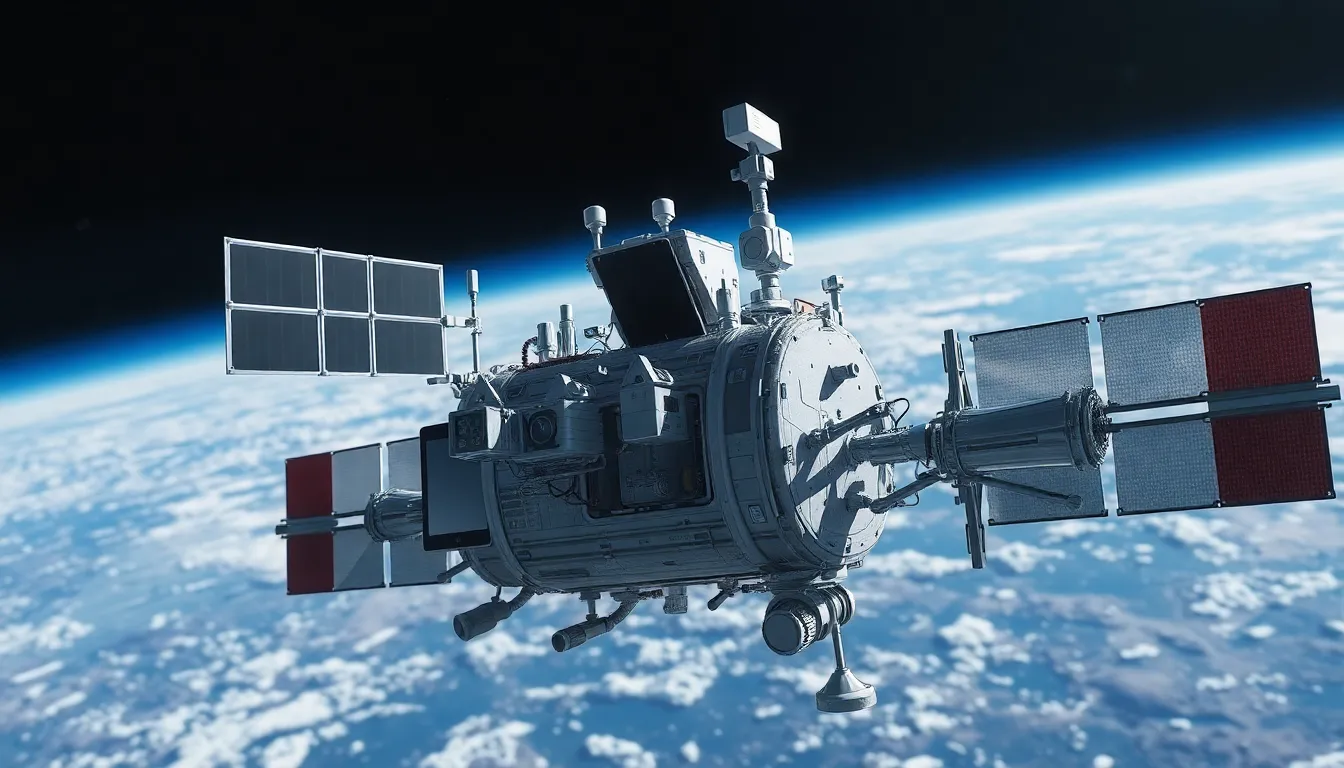Table of Contents
ToggleIn the ever-evolving realm of aerospace technology, dynamic space systems are becoming a game-changer. These innovative systems adapt in real-time to the unpredictable conditions of space, enhancing mission success and operational efficiency. With advancements in artificial intelligence and machine learning, they’re redefining how spacecraft navigate and communicate, making space exploration more accessible than ever.
As humanity pushes further into the cosmos, understanding the intricacies of dynamic space systems is crucial. From satellite networks to interplanetary missions, these systems provide the flexibility needed to tackle challenges in an environment where every second counts. The future of space exploration hinges on these adaptable technologies, promising exciting developments on the horizon.
Overview of Dynamic Space Systems
Dynamic space systems encompass technologies designed to operate under varying conditions, adjusting seamlessly to challenges presented by the space environment. These systems leverage advanced algorithms and real-time data to enhance performance, reliability, and scalability in space missions.
Dynamic adaptability characterizes key features of these systems, including the ability to modify orbital paths or adjust communication protocols based on situational feedback. For instance, satellites equipped with dynamic systems can autonomously optimize trajectory changes in response to unforeseen obstacles or orbital debris.
Artificial intelligence (AI) significantly contributes to the functionality of dynamic space systems. AI algorithms analyze vast amounts of data gathered from various sources, facilitating smarter decision-making processes. Machine learning models enable spacecraft to predict conditions and respond appropriately, thus increasing the likelihood of mission success.
Dynamic space systems play a vital role in satellite networks by ensuring robust connectivity and minimizing downtime. Enhanced communication allows for real-time updates and coordination among multiple satellites, which is crucial for both Earth observation and interplanetary missions.
Interplanetary exploration benefits from the flexibility of dynamic space systems. These systems provide precise navigation tools that adapt to the complexities of celestial mechanics. As humanity’s exploration efforts expand beyond Earth, the integration of dynamic technologies becomes essential for conducting safe and efficient missions.
Dynamic space systems represent a significant advancement in aerospace technology, featuring adaptability and intelligence that meet the demands of modern space exploration. Their successful application will directly contribute to the future advancements of space missions, enhancing exploration potentials and communication reliability.
Key Components of Dynamic Space Systems


Dynamic space systems rely on several critical components that facilitate their adaptability and effectiveness in the complex environment of space. These components ensure seamless operation, efficiency, and reliability for various missions.
Sensors and Actuators
Sensors play a vital role in dynamic space systems by gathering real-time data on environmental conditions and spacecraft status. They include:
- Inertial Measurement Units (IMUs): Track orientation and acceleration to maintain accurate positioning.
- Radiation Sensors: Monitor radiation levels to protect sensitive equipment and ensure crew safety.
- Optical Sensors: Capture visual data for navigation and obstacle detection.
Actuators, on the other hand, enable spacecraft to perform specific actions based on sensor inputs. They include:
- Thrusters: Adjust trajectory and altitude with precise control.
- Gimbals: Alter the orientation of instruments or antennas for optimal performance.
Together, sensors and actuators form a feedback loop, where real-time data informs immediate responses, enhancing mission adaptability.
Communication Systems
Communication systems in dynamic space systems ensure reliable data transfer between spacecraft and ground control. Key components include:
- Transponders: Facilitate two-way communication, transmitting and receiving signals with high fidelity.
- Antennas: Direct signals to minimize interference and maintain strong connections.
- Signal Processing Units: Enhance data quality by filtering noise and ensuring clarity.
These systems adapt to changing conditions, such as distance and atmospheric interference, optimizing signal strength and maintaining continuous communication. By leveraging advanced algorithms, dynamic communication systems enhance responsiveness and mission coordination, essential for operational efficiency.
Applications of Dynamic Space Systems
Dynamic space systems play a crucial role in various aerospace applications, particularly in enhancing operational capabilities and mission success rates.
Satellite Navigation
Satellite navigation systems utilize dynamic space systems for precise positioning and tracking. These systems adjust their orbits in real-time based on environmental data and operational requirements. Advanced algorithms process signals from multiple satellites to ensure accuracy within meters. Real-time feedback mechanisms enable satellites to correct their trajectories autonomously, maintaining optimal alignment for communication and data collection. These adaptations significantly enhance global positioning services, making them more reliable for applications such as disaster response, vehicle navigation, and geolocation services.
Autonomous Spacecraft
Autonomous spacecraft leverage dynamic space systems to operate independently in challenging space environments. Equipped with AI-driven technologies, these spacecraft assess real-time data from various sensors, including Inertial Measurement Units and radiation sensors. This data informs immediate decisions, such as altering course to avoid space debris or adjusting payload operations based on mission objectives. Such capabilities enhance the efficiency and safety of missions, including planetary exploration and cargo transport between space stations. By enabling autonomous decision-making, dynamic space systems reduce reliance on ground control, resulting in faster response times and improved mission resilience.
Challenges in Dynamic Space Systems
Dynamic space systems face several challenges that affect their performance, adaptability, and overall mission success. These challenges primarily arise from environmental factors and technological limitations.
Environmental Factors
Environmental factors significantly impact the operation of dynamic space systems. Space radiation, micrometeoroids, and extreme temperature variations pose threats that can disrupt system functionality.
- Radiation Exposure: High levels of radiation can damage electronic components, leading to failures in sensors and communication systems.
- Micrometeoroids: Small particles in space can collide with spacecraft, damaging surfaces and potentially impacting operations.
- Temperature Extremes: Fluctuating temperatures in space require robust thermal management to maintain optimal functioning of systems.
These factors necessitate the integration of advanced shielding and design techniques to ensure resilience against the harsh and unpredictable conditions of space.
Technological Limitations
Technological limitations serve as additional challenges for dynamic space systems, affecting their scalability and responsiveness.
- Data Processing Speed: The vast amount of data generated requires rapid processing and analysis, which can strain onboard systems.
- Power Constraints: Limited power availability impacts the operational capacity of sensors and communication equipment, especially during extended missions.
- Algorithm Accuracy: Developing algorithms that can efficiently adapt to real-time changes remains a complex endeavor, as inaccuracies can lead to poor decision-making.
Addressing these technological limitations involves continuous innovation and enhancement of hardware and algorithms to improve overall system performance.
Future Trends in Dynamic Space Systems
Future trends in dynamic space systems focus on advanced technologies and sustainable practices. These developments shape the landscape of space exploration, enhancing efficiency and adaptability.
Artificial Intelligence Integration
Artificial intelligence (AI) integration in dynamic space systems enhances autonomy and operational efficiency. AI algorithms process large datasets from various sensors, enabling real-time decision-making. For example, AI systems can predict and respond to changes in environmental conditions, such as solar flares or space debris, allowing spacecraft to adjust trajectories autonomously. Machine learning models improve over time by analyzing past mission data, optimizing navigation and communication protocols. This integration increases accuracy, reduces human error, and enhances overall mission resilience. The application of AI in satellite networks also strengthens connectivity and bandwidth management, ensuring reliable data transfer in fluctuating space environments.
Sustainable Design Practices
Sustainable design practices gain importance in the development of dynamic space systems. These practices focus on minimizing environmental impacts and ensuring long-term viability in space exploration. For instance, the use of recyclable materials in satellite construction reduces waste and resource consumption. Additionally, energy-efficient technologies, such as solar power systems, enable spacecraft to operate sustainably. Adopting modular designs allows for easier upgrades and repairs, extending mission lifespans and reducing costs. Furthermore, advanced propulsion systems, like ion thrusters, reduce fuel consumption and emissions. Implementing these sustainable practices aligns with global efforts to promote responsible space exploration and reduces the ecological footprint of space missions.







